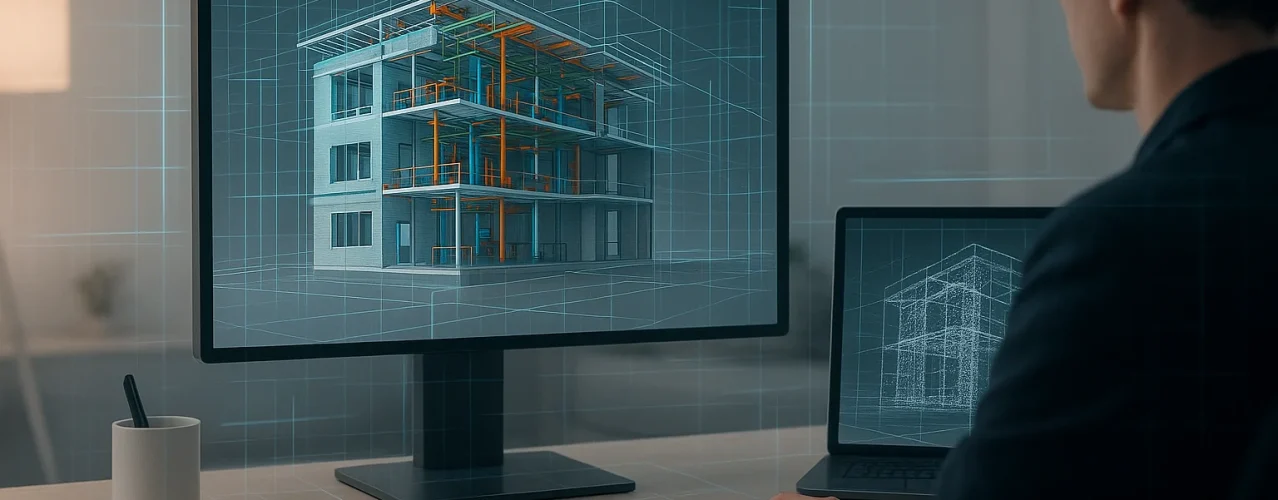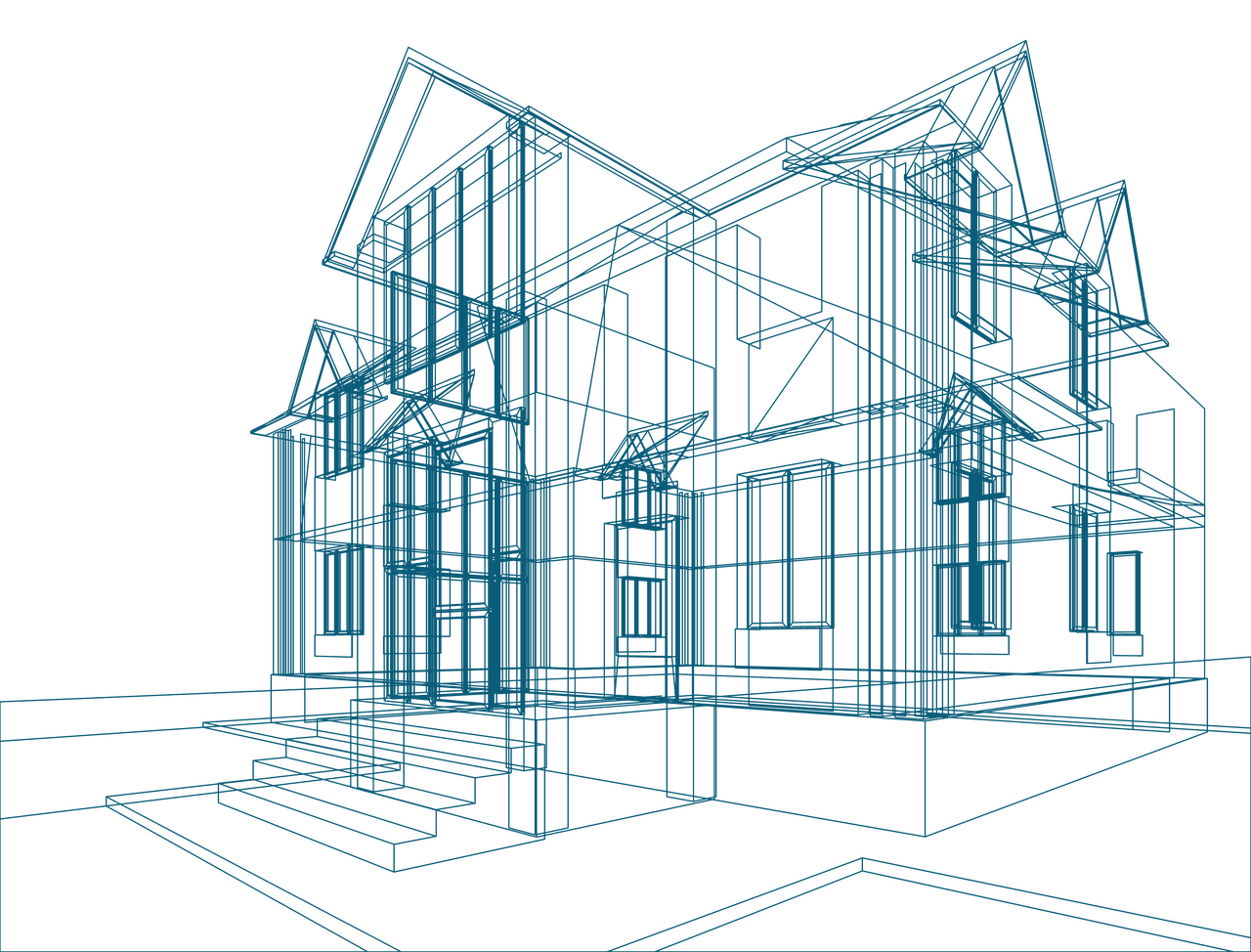

Market report
Contractor Insights & Market Performance
Discover how market research simplifies complex construction decisions and provides a competitive edge. Unlock insights that drive success in your projects.
Blogs I published 22 April 2025 I Dirk Hoogenboom
BIM in Construction - What the Numbers Really Say
Some time ago, all you needed to get going on-site was a printed drawing, a clipboard and a team that knew how to make it happen. But if you’ve been in the industry, you’ve felt the shift. Projects are getting more complex, margins tighter and expectations higher. Clients want clarity. Cities want sustainability. And contractors? They want to build smarter.
That’s why Building Information Modeling – BIM – is making strides lately. Well, somewhat. It’s a tool that promises problem-solving, yet for most contractors in Europe, it’s still something they might get around to.
Let’s take a look at the basics and figure out where BIM stands in 2025, what it’s doing for those who use it and why the rest are still holding off.
BIM Awareness High, Usage… Low
There’s a noticeable gap between knowing BIM and implementing it. Nearly half of contractors across Europe, around 47%, know what it is, but when it comes to actually using it on projects? We’re looking at about 1 in 10 contractors. That gap, awareness vs. application, is telling. Compare this to 92% awareness and 45% usage among architects and you’ll see that contractors are playing catch-up.
Some countries are ahead of the curve. In the Netherlands, for example, 79% of contractors are aware of BIM, and 42% are actually using it, by far the leaders in Europe. In Spain and the UK, usage is creeping up to around a quarter of contractors, but in countries like France, Italy or Poland, awareness is moderate, interest low and usage barely cracks single digits.
Germany is a bit of an outlier. Awareness has jumped massively since 2022, largely due to BIM becoming mandatory for public building projects. But even with that rule in place, actual use of BIM among German contractors is still low. Why? Because not every contractor works on public jobs, and adoption takes time, especially when you’re juggling labor shortages, pricing pressure and shifting regulations.
Why Aren’t More Contractors Using BIM?
The reasons are less about resistance and more about reality and/or practicality.
A Familiar Trend…
First off, BIM is very much a new-build game, and the market has been under pressure. With rising costs, labor shortages and tighter regulations, large-scale projects aren’t happening as much. Fewer new builds mean less need for BIM. Simple as that. Smaller firms don’t see the value in investing in it when the projects they’re working on are too small (20%), when the company is too small (20%) nor when their projects don’t demand that level of complexity. 19% have even said they haven’t considered it at all.
Lack of Ecosystem Alignment
Perhaps the most cited challenge among BIM users is exchangeability. Only 10% of main project stakeholders (contractors, HVAC, electrical installers) use BIM, and that means problems for collaboration. This mismatch leads to friction, data silos and rework – all of which diminish BIM’s potential to streamline workflows. So, it’s no wonder it stacks up as a pain-point for 59% of contractors.
Cost, Complexity & Training
Other limiting factors include the need for financial investment (13%), training and knowledge gaps (9%) and perceived complexity (7%). Simply put: many contractors aren’t against BIM—they just aren’t ready for it yet.

What’s In It for the Ones Who Do Use BIM?
Contractors who are using BIM say the benefits are real. Top of the list is efficiency (67%). Jobs run smoother, there’s fewer surprises and delays. In the off-chance things do go wrong, they catch issues earlier thanks to tools like clash detection and quantity take-offs (59%). Better overall planning is at 14%.
Another big win is the ROI. In projects where BIM isn’t used, failure – what gets ripped out, redone or reordered – costs, on average over 11%. With BIM, those costs drop to about 7%. And when contractors go a step further and tap into more advanced features like 4D planning, 5D cost tracking, failure costs dip even lower.
These numbers aren’t marketing fluff. They’re verified data: BIM pays for itself. Not overnight, but consistently.
More Work To Be Done
Let’s be clear: most contractors using BIM today are only using the basics. Nearly all rely on 3D visualization (81%), 2D drawing generation (77%) and clash detection (76%). And that’s fine, especially if it helps streamline the process. But those who take advantage of BIM’s full feature set are few.
Only about a third are using features like 4D BIM (planning integration, 28%), 5D BIM (cost estimation, 31%), or 6D and 7D features that bring sustainability and lifecycle maintenance into the mix.
Meaning, there’s quite an untapped potential there. These features are tailor-made for contractors, but they’re still underused, partly because of the issues we’ve mentioned (lack of training, coordination problems, and the complexity of getting everyone on the same page). So, even among the BIM crowd, there’s room to grow.
BIM Isn’t One-Size-Fits-All
The European construction market is anything but uniform and BIM adoption rates reflect that. In the Netherlands, it’s become second nature. Contractors there are using BIM in the majority of their projects, and they’ve built a culture around it. In Spain and the UK, BIM use is growing steadily, helped by stronger project pipelines and a shift toward more complex, higher-margin work where BIM’s benefits really come through. Germany is catching up due to public mandates, but private sector adoption is lagging.
Meanwhile, in countries like France, Poland and Italy, BIM is still seen as a future consideration rather than a current need. In Italy, most contractors – a whopping 60% of them – actually say they never plan to use it, making it the most skeptical market, driven mostly by fragmentation and project scale.
Future Outlook – What Could Push BIM Forward
Despite the current hiccups, BIM isn’t standing still. There are clear drivers that could accelerate adoption:
- Public mandates – As more governments make BIM mandatory for public work, contractors will have to follow suit, or risk losing out on valuable tenders
- Prefab and industrialization – The shift toward off-site construction and prefab methods relies heavily on precise coordination and planning. So, as prefab rebounds post-2024, BIM should follow along
- Labor shortages – With skilled labor hard to find, firms are looking at tech to do more with less. BIM helps bridge that gap by reducing rework, improving planning and making better use of crew hours
- Sustainability requirements – As green building standards tighten and clients demand more transparency on materials, energy and lifecycle impact, BIM will become essential
Contractors also report that 42% of their BIM projects involve model handover to the client—hinting at a shift toward lifecycle thinking, which will grow as sustainability and maintenance planning become more central.
Conclusion
No one’s pretending that BIM is easy to implement. But based on the numbers, the pain is frontloaded, and the payoff long-term. BIM isn’t a tool that helps out in a pinch, but a strategy shift that moves you away from reactive firefighting to proactive planning.
And while the European contractor market is still fragmented in its adoption, there’s clear momentum. More firms are getting on board, especially in countries where digital mandates, prefab and sustainability are reshaping the construction landscape. So if your company’s rethinking its day-to-day, BIM could save you time, cost and chaos. And that’s just the starting point. It doesn’t need to be an all-or-nothing leap. Just a better way to start your next job.
Want to closer look at BIM? Get in touch. We have blogs, webinars and detailed reports to help you figure out how it fits into your next move.
Construction Consulting Services for You
We provide tailor-made market research and off-the-shelf reports, both B2B & B2C, qualitative and quantitative. Here are some you might be interested in
Monitor and improve client relationships to drive loyalty and repeat business in construction.
Map out key interactions and pain points to refine the overall construction experience.
Identify the aspects of service or product that most impact satisfaction in construction projects.

Read more


04 April 2025 I Dirk Hoogenboom
Construction Decisions Aren’t Simple – Why Market Research Gives a Competitive Edge


24 March 2025 I Dirk Hoogenboom
Why Are Clients Pulling Back on Sustainable Construction Investments?


20 February 2025 I Dirk Hoogenboom
Smart Materials & Tech – the Future of Architecture?


06 February 2025 I Dirk Hoogenboom
The Green Shift in Painting – Sustainability and Practicality

Fresh Insights Await
Our relevant reports
Delve into the newest findings across various market segments, crafted for a cutting-edge overview. Explore our insightful reports, brimming with up-to-date data, trend analyses, and in-depth examinations, all tailored to provide you with a comprehensive understanding of the current market dynamics.
Construction
Home Improvement
Installation
Special reports
Construction
Smart Materials and Buildings Q4 2024
2024 85 pages
Explore the evolving future in construction sector among European architects in Q4 2024. Delve into the factors driving material preferences and the impact on construction aesthetics and sustainability.
2,000 Euro
Construction
Digitalisation and BIM H2 2024
2025 64 pages
Uncover the preferred purchase channels of contractors in H2 2024, and understand how purchasing behaviors evolved. This report provides insights into the factors influencing purchasing decisions among contractors.
6,000 Euro
Construction
Decision making process Q3 2024
2024 87 pages
Unveil the decision-making processes in the construction industry through the lens of European architects. Discover the factors that influence crucial decisions and the interplay among different stakeholders.
2,000 Euro
Construction
Prefab H1 2024
2024 63 pages
Discover the adoption rate and benefits of prefabrication technology among European contractors in H1 2024. Understand the driving forces behind prefab usage and its impact on project efficiency and cost-saving.
6,000 Euro
Construction
Future of construction Q2 2024
2024 82 pages
Explore the evolving future in construction sector among European architects in Q2 2024. Delve into the factors driving material preferences and the impact on construction aesthetics and sustainability.
2,000 Euro
Construction
Sustainability 2024
2024 72 pages
Painter Insight Monitor 2024 will focus on understanding the specific needs, preferences, and challenges faced by painters when it comes to sustainable products.
11,000 Euro
Home Improvement
DIY vs DIFM Q4 2024
2025 76 pages
Explore the prevailing trends between DIY and DIFM in Q4 2024. Understand consumer preferences and the factors influencing their choice between DIY and DIFM.
3,500 Euros
Home Improvement
Branding Q3 2024
2024 74 pages
Discover the power of branding in the home improvement sector. Explore how strong branding influences consumer preferences and purchase decisions.
3,500 Euro
Home Improvement
European Garden Monitor
2023 43 pages
Explore the European Garden Monitor, a comprehensive platform dedicated to garden health monitoring in Europe. Access valuable resources and expert advice today.
12,000 Euro
Home Improvement
Purchase channels Q2 2024
2024 90 pages
The European Home Improvement Monitor offers valuable insights on purchase channels in the European home improvement industry, examining the evolving preferences and behaviors of consumers across traditional retail and emerging online platforms.
3,500 Euro
Home Improvement
Sustainability Q1 2024
2024 81 pages
Delve into sustainability trends in the home improvement sector in Q1 2024. Discover consumer preferences and the shift towards eco-friendly home improvement solutions.
3,500 Euro
Home Improvement
DIY versus DIFM Q4 2021
2024 113 pages
This report is a must-have if you’re in the home improvement industry. It provides a wealth of information on the behaviour of DIY and DIFM consumers, their motivations, and the factors that influence their purchasing decisions.
3,150 Euro
Installation
Training needs Q1 2025
2025 100 pages
This report offers an overview of installers’ habits and preferences concerning their education. Furthermore, the report encompasses the pervasive challenge of workforce shortage and explores the sector’s strategies for resolving this issue.
3,250 Euro
Installation
Media orientation Q4 2024
2025 128 pages
The European Mechanical Installation Monitor report provides a detailed analysis of the plumbing and HVAC industry. This report specifically focuses on Media Orientation in the industry.
2,800 Euro
Installation
Services in the installation sector Q4 2024
2025 102 pages
This report provides a comprehensive view of the installer's requirements for services from manufacturers. Within the report, you will find information on the most needed services in each category: commercial processes, engineering, products & installation, and repair & maintenance. It also examines the services that installers offer to their customers.
3,250 Euro
Installation
Prefab Q3 2024
2024 110 pages
Uncover the adoption of prefabricated products in HVAC installations during Q2 2022. Delve into the benefits and challenges associated with prefabrication in HVAC.
2,800 Euro
Installation
Prefab Q3 2024
2024 119 pages
This report offers a comprehensive view of the installers’ involvement and needs regarding prefabricated electrical installations.
3,250 Euro
Installation
Smart & Connected Products Q2 2024
2024 120 pages
This report provides a comprehensive view of the attitudes of installers toward smart building solutions, specifically among electrical installers and their clients. In the report, you will find insights into the installers' experiences with installing smart products and the willingness of end users to invest in such solutions, as well as their motivations and pain points.
3,250 Euro
Special reports
European Sustainability Report 2024
2025 51 pages
This report provides in-depth insights based on triangulation of key market information and data as well as data from USP Marketing Consultancy’s key monitors that are carried out year in, year out. The focus of this report is on the most important stakeholders within the construction industry, namely architects, contractors, electrical and HVAC installers within The United Kingdom, The Netherlands, Belgium, Germany, Poland, France, Italy, and Spain.
3,950 Euro
Special reports
European Sustainability Report 2024
2024 51 pages
This report provides in-depth insights based on triangulation of key market information and data as well as data from USP Marketing Consultancy’s key monitors that are carried out year in, year out. The focus of this report is on the most important stakeholders within the construction industry, namely architects, contractors, electrical and HVAC installers within The United Kingdom, The Netherlands, Belgium, Germany, Poland, France, Italy, and Spain.
3,950 Euro









